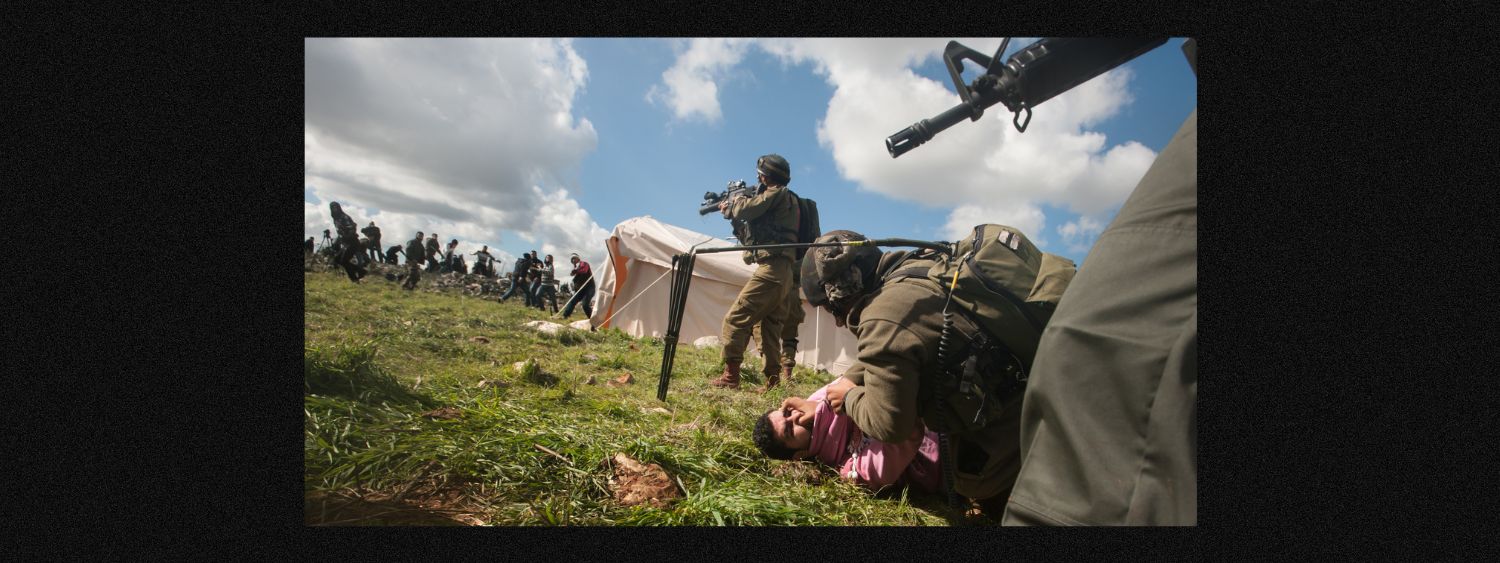Almost exactly ten years ago a photographer friend and I were staying in the West Bank village of Burin, just outside of Nablus. We had planned to be there for a month, but our visit was cut short by violence from an unexpected source, and in the end I don’t think we stayed much longer than a week.
All my memories of Burin feel like hallucinations, or like dreams. I had first been there perhaps a year earlier, to report on a demonstration. I remember being struck by the ferocity of the village’s beauty—a cluster of small stone houses on steep, narrow, twisting streets at the base of a valley that in the springtime is almost impossibly bright and green. But it is Burin’s ill fortune to be located directly beneath two particularly aggressive Israeli settlements.
One of them, Yitzhar, was and remains one of the most violent in the West Bank, a bastion of messianic Zionism in its most extreme form. Two rabbis living there are the authors of the infamous The King’s Torah, which justifies the murder of non-Jews, even infants, if “it is clear that that they will grow up to harm us, and in such a situation they may be harmed deliberately, and not only during combat with adults.” The rabbis’ God-bitten followers routinely harass the people of Burin, attacking shepherds and farmers, burning fields and orchards, uprooting olive and almond trees, at times descending into the village to hurt whomever they can find.
At that demonstration, I remember looking uphill to see dozens of bearded, white-robed settlers charging down the slope like discarded extras from an Old Testament epic. They threw stones until the Israeli soldiers managed to get between them and us, and then it was the soldiers who were attacking us, firing tear gas grenades until the wildflowers disappeared in a thick mist of noxious gas. I remember a Palestinian man stumbling and an Israeli soldier standing on his chest while other soldiers kicked and punched him. I remember joining a group of journalists who had crowded together—for safety, we thought—until the soldiers began targeting us, shooting directly at us. But that might have been another demonstration on another day. After ten years, the memories bleed together.
I do remember running to take cover beneath a low stone wall where a man whose face I didn’t see—I only ever saw the shoulders of his brown leather jacket—pulled me to him and threw his arms around me. I don’t know if he was trying to protect me from the gas or the grenades or to comfort himself. It’s even possible that it was I who reached out to him, but either way I returned his embrace and we crouched there with our heads pressed into each other’s shoulders, hugging one another tightly until the explosions ceased and the gas had dispersed and we stood and parted, slightly abashed, without a word or a glance. Oh fierce and mighty IDF, I remember thinking later, do you not know how much tenderness you breed?
Sometimes you hear an echo of a sound that has not yet been voiced, of a shot that has not yet been fired. Things repeat, but they repeat before the original event.When I returned to Burin a year later, we slept on the living room floor in the home of an activist who lived on the edge of the village. He was an intense young man, brooding and distracted, as if an actual fire were burning somewhere inside him and it took his constant attention to make it sure it didn’t spread. It did though. I’ll leave his full name out of this because it’s been a long time and I’m sure he doesn’t need the extra trouble. His family name, though, was Najjar. There are more than a few Najjars in Burin.
I remember walking the hills with him or with his cousin, birds singing and poppies blooming everywhere, the air thick with the scent of sage and za’atar. One night we climbed to a high point above the village where the young men sat around a fire, keeping watch for army incursions or any sign of settlers. One of them, I remember, tossed a cigarette lighter into the fire and everyone scattered and ducked, giggling with anticipation as they waited for the explosion.
I remember getting lost in the dark in Burin’s twisting alleys, not being able to find the right house. I don’t remember any relatives coming by to visit with babies, but there must have been some, because that’s what people do in Palestinian villages, they visit friends, relatives, neighbors, and sit outside when it’s warm enough, drinking tea or coffee, joking, smoking, talking in a slow, roundabout way, admiring the babies, laughing with the children.
You see, I am leading somewhere with these memories. On our last afternoon in Burin we piled into a car to go to the hospital in Nablus, to visit an old man who had collapsed during a demonstration earlier that day. We had just turned the next to last bend before the road leaves the village. It all happened quickly. I was in the back seat. I must have been looking out the window, at the soft light on green fields sprayed with mustard and poppies. The driver was taking his time. If he had been going any faster, the rock would almost certainly have come through the windshield and hit him in the face and the car would have likely left the road. Instead the windshield shattered in an uneven, grapefruit-sized grid directly in front of his forehead, leaving a fine dusting of powdered glass all over the dashboard. He slammed the brakes. He and our host jumped out of the car to chase down whoever had thrown the stone.
They never found him, but they thought they knew who had done it. Not settlers, they said, and not Israelis, but someone from the village, which was split between two political factions, the ruling Fatah party and the leftist Popular Front for the Liberation of Palestine. I suspect it was messier than that, and more personal—if that rock had been meant as a message, it was the sort of message that could easily kill—but our host didn’t feel like explaining. Whatever was going to happen next could not happen with foreign journalists around. Our welcome in Burin had ended.
I don’t remember how we made our way to Nablus, only that we did. Our host met us there later, at the apartment of a friend of his. The pressure finally got to him that night: he passed out cold in the middle of a conversation, crumbling to the floor in front of us. When he came to he was weeping.
For a while I kept in touch with our host in Burin, but then he was arrested and sent to a prison somewhere in Israel, and his phone stopped working for good.Invisible threads connect the future to the past. Weave enough of them and you get a web. You get the substance of the universe. Sometimes something happens and we catch enough of a glimpse to see that time is not, as we’ve been told, just a straight line that moves in one direction. It is a ripple across the weave of the web. It moves in all directions at once, like a stone breaking the surface of the sea. Sometimes you hear an echo of a sound that has not yet been voiced, of a shot that has not yet been fired. Things repeat, but they repeat before the original event. The reflection precedes the image. These metaphors don’t quite get me there, but that’s the only way I can understand what happened that day. If this sounds irrational, look around and tell me, what do you see that suggests that we live in a universe that is obedient to reason?
For a while I kept in touch with our host in Burin, but then he was arrested and sent to a prison somewhere in Israel, and his phone stopped working for good. I thought about him sometimes, about those green hills, and about that grapefruit-sized rock smashing the windshield, but if I’m honest, I haven’t though about Burin that often. Many other and graver acts of violence have eclipsed what happened there, and it was to those that my memory returned. I remembered Burin mainly when it briefly crossed the headlines—never in the American newspapers, but sometimes in Ha’aretz if an Israeli activist was among those attacked by settlers—or when it showed up in my social media feed.
But it was not the names “Burin” or “Najjar” that caught my attention when I noticed a post with a photo of a slender little boy. For the last five months my feeds have been filled with the faces of Palestinian children. I know that their presence there means that they are dead. It wasn’t the boy’s face either, his dark eyes staring at the camera lens with obvious pride. What made me stop scrolling was the painting the boy was holding for the camera. It was more of a diorama really, a sheet of black construction paper onto which colorful balls of what looked like felt had been glued to represent the planets, their orbits sketched in white. Jupiter was there with its ring. Earth was blue. The sun was glorious, painted yellow and orange and girdled with a lion’s mane of rays.
I read the caption and clicked the link. His name was Amr Mohammad Ghaleb Najjar. He was from Burin. He was ten years old, which means he would have been a baby, perhaps a newborn when I was there. He was surely a relative of my hosts. I might have met him, cooed over him as etiquette requires. He had been sitting in his father’s car late in the afternoon, driving down the one road that leads in and out of the village when a bullet fired by an Israeli soldier hit him in the head. The light surely was soft.
Nothing I could find online provided any additional context, but none was needed. It was an ordinary occurrence. Two teenagers were killed by the Israeli military a few minutes away in Nablus that same day. Their names were Mustafa Abu Shalbak and Mohammed Mahmoud Raja Eid. In Gaza, too many children to name are dying daily not only from bullets and bombs but from hunger now. The universe shivers for each of them. In all directions, the reverberations will not end.
_______________________
This essay originally appeared at Flaming Hydra. Featured image by Ryan Rodrick Beiler/Activestills.



